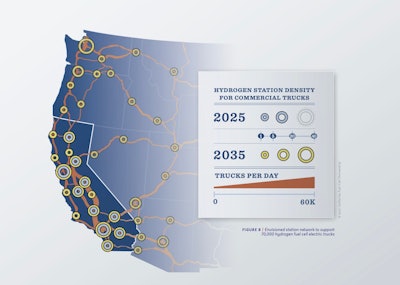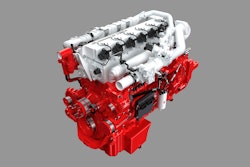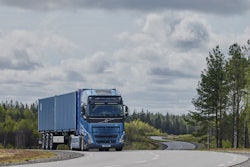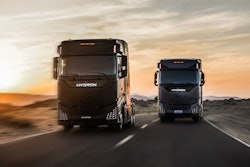
Hydrogen internal combustion and fuel cell powertrains show real promise in helping fleets to slash emissions while providing the power, quick refueling and lighter GVWR needed to move heavy loads beyond the limits of battery-powered trucks.
However, as Commercial Carrier Journal learned recently at the Advanced Clean Transportation Expo, fleets continue to express concern about gaining access to hydrogen particularly if they reside outside of California, which is ground zero for the growing zero-emission fuel cell truck segment. (While impressive with near-zero emissions, hydrogen internal combustion hasn’t reached zero emissions, a critical goal for California and other states that champion the nation’s most aggressive goals for cutting and eventually eliminating emissions in the transportation sector).
A U.S. Department of Energy map currently shows only 48 hydrogen (H2) fueling stations in the U.S. and five in Canada. All 48 stations in the U.S. are confined to California, home to the nation’s busiest ports and busiest trucking hubs.
Sizing up H2 station development within the Golden State is fairly easy. Type in a few key words and the web responds with a tsunami of information. Most notably, the California Energy Commission announced in December 2020 a plan to add an additional 111 hydrogen stations in the state by 2027 to support passenger cars, trucks and buses. By 2025, California anticipates having up to 200 stations to support fuel-cell vehicles, a 317% jump from its four dozen stations.
 Counting on Class 8 trucks. Here's what a hydrogen station deployment could look like in 2025 and 2035 according to the California Fuel Cell Partnership. "There should be a discussion initiated on establishing an approach for a national [hydrogen] infrastructure and, in my opinion, it should focus on long haul trucking," said CFCP Technical Program Manger Nico Bouwkamp.California Fuel Cell Partnership
Counting on Class 8 trucks. Here's what a hydrogen station deployment could look like in 2025 and 2035 according to the California Fuel Cell Partnership. "There should be a discussion initiated on establishing an approach for a national [hydrogen] infrastructure and, in my opinion, it should focus on long haul trucking," said CFCP Technical Program Manger Nico Bouwkamp.California Fuel Cell Partnership
“As the market expands, hydrogen fueling stations will be matched with vehicle rollout as both grow together,” the DOE states on its website. “Customers are expected to have similar experiences at hydrogen fueling stations as at gasoline stations, with most hydrogen dispensers being added at existing gasoline stations.”
Shell, currently the top player in H2 station development for trucks in the U.S., won’t say much about their future plans. The global energy giant recently made headlines following a strategic station roll-out in Southern California.
“Our Long Beach, Ontario and Wilmington hydrogen fueling stations form the first hydrogen truck refueling network in North America,” a company statement to CCJ reads. “Further growth will follow demand and policy frameworks that support hydrogen.”
Policy framework in the U.S. has certainly been growing. Last year, the Bipartisan Infrastructure Law approved a $9.5 billion boost in federal aid for the nascent hydrogen industry, with $8 billion being earmarked for hydrogen hubs. Those hubs, according to the DOE, will create networks of hydrogen producers, consumers and local connective infrastructure to accelerate the use of hydrogen as a clean energy carrier.
But unlike California, the fed’s plans for station rollouts aren’t exactly a few clicks away. CCJ also tried contacting the DOE directly but didn’t hear back from the agency by press time.
Rolling out a national plan
The federal government’s plan to boost the hydrogen industry is complex and depends largely on cooperation from competing private interests.To help stimulate collaboration, innovation and investment, the DOE has been sponsoring H2 events, soliciting input from industry stakeholders and supporting various awards including the new Hydrogen Shot Incubator Prize which offers a $2.5 million prize to identify, develop, and test disruptive technologies that reduce the cost of clean hydrogen production and meet the DOE’s Hydrogen Shot goal of $1 per kilogram of clean hydrogen in one decade, an 80% drop from today’s prices. According to alt fuel research group Rocky Mountain Institute, the energy of 1 kilogram of hydrogen in a fuel cell equates to roughly one gallon of diesel.
But getting to $1 per kilogram will take years and in the meantime fleets are banking on OEMs, fuel suppliers and policy makers to make all the right moves to ensure a smooth transition to zero emission fuel cells. Most important of all in this mix could be the fuel producers.
“I think you have to have the infrastructure first for certain,” said California Fuel Cell Partnership Executive Director Bill Elrick. “We've got to have that infrastructure out front. It's all doable if it's planned in unison. It's not really a chicken and egg, it's chicken and chicken feed getting the stations right out in front of the vehicles.”
The California Fuel Cell Partnership (CFCP), which fosters collaboration between private and government entities for the advancement of fuel cell vehicles, published a map that envisions what an H2 station rollout might look like over the next 13 years.
The map, which appears in a 2021 CFCP report titled “Fuel Cell Electric Trucks: A vision for freight movement in California and beyond,” shows H2 stations along major trucking routes to support up to 70,000 fuel cell trucks throughout Arizona, California, Idaho, Montana, Nevada, Oregon, Utah and Washington State.
Though the year-old map does not go further west than Arizona, Elrick pointed out that station plans are a work in progress and does not rule out states well beyond Arizona.
“California gets the lead because it’s been so aggressive with carrots and sticks for all of transportation,” Elrick said, "but I think the next market that looks most interesting is Texas.”
Electricity generated from Texas’ zero-emission wind and solar power plants can be used to produce green hydrogen, which offers fleets the lowest carbon intensity score.
“They could do a lot of interesting things on hydrogen production there,” Elrick added. “If you look at freight traffic and we're looking at that very carefully right now while working on an outline of a national hydrogen mobility strategy, we’re seeing that really the biggest corridors across the U.S., the one that stands out, and I'm going to simplify it, is the Port of L.A. to mid-Texas and then up to Chicago.”
CFCP Technical Program Manger Nico Bouwkamp said the DOE’s plan to fund four hydrogen hubs should take freight-sensitive locations into consideration.
“The question is then, ‘Where do you start and how do you go about that?’” Bouwkamp said. “And I saw that using the Eisenhower Interstate network as a basis, not including all the highways that exist in all the related roads, but starting with that and connecting the 10 major ports in the U.S. based in volume and connecting those as well as the production centers in Chicago and Detroit area is probably a good start instead of trying to cover all of the U.S.”
Bouwkamp said a national plan that supports long-haul trucking would be best while regional or state-based station rollouts could work in parallel. Coordinating such efforts, Bouwkamp added, can be challenging and may lead to bureaucratic hang-ups if not handled correctly.
“I think it's probably a better approach to let industry figure that out, how to coordinate this instead of government taking the initiative,” he said.












